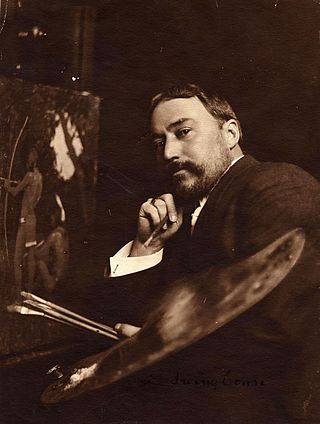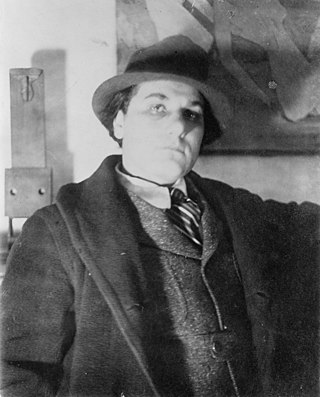Related Research Articles

Eanger Irving Couse was an American artist and a founding member and first president of the Taos Society of Artists. Born and reared in Saginaw, Michigan, he went to New York City and Paris to study art. While spending summers in Taos, New Mexico, he began to make the paintings of Native Americans, New Mexico, and the American Southwest for which he is best known. He later settled full time in Taos.

The Smithsonian Institution, or simply the Smithsonian, is a group of museums, education and research centers, the largest such complex in the world, created by the U.S. government "for the increase and diffusion of knowledge." Founded on August 10, 1846, it operates as a trust instrumentality and is not formally a part of any of the three branches of the federal government. The institution is named after its founding donor, British scientist James Smithson. It was originally organized as the United States National Museum, but that name ceased to exist administratively in 1967.

George Catlin was an American lawyer, painter, author, and traveler, who specialized in portraits of Native Americans in the American frontier.

William Zorach was an American sculptor, painter, printmaker, and writer. He won the Logan Medal of the arts. He is notable for being at the forefront of American artists embracing cubism, as well as for his sculpture.

Harvey Thomas Dunn NA, also known as J. Harvey Dunn, was an American painter and teacher. During World War I, Dunn was an artist-correspondent with the American Expeditionary Forces in Europe. Most of Dunn's war sketches are housed at the Smithsonian Institution in the National Museum of American History in Washington, D.C. He is best known for his prairie-intimate masterpiece, The Prairie is My Garden (1950). In this painting, a mother and her two children are out gathering flowers from the quintessential prairie of the Great Plains.

Frank Duveneck was an American figure and portrait painter.

Sam Gilliam was an American color field painter and lyrical abstractionist artist. Gilliam was associated with the Washington Color School, a group of Washington, D.C.-area artists that developed a form of abstract art from color field painting in the 1950s and 1960s. His works have also been described as belonging to abstract expressionism and lyrical abstraction. He worked on stretched, draped and wrapped canvas, and added sculptural 3D elements. He was recognized as the first artist to introduce the idea of a draped, painted canvas hanging without stretcher bars around 1965. This was a major contribution to the Color Field School and has had a lasting impact on the contemporary art canon. Arne Glimcher, Gilliam's art dealer at Pace Gallery, wrote following his death that "His experiments with color and surface are right up there with the achievements of Rothko and Pollock."

The Montclair Art Museum (MAM) is located in Montclair, New Jersey and holds a collection of over 12,000 objects showcasing American and Native North American art. Through its public programs, art classes, and exhibitions, MAM strives to create experiences that inspire, challenge, and foster community to shape our shared future.

Betty Parsons was an American artist, art dealer, and collector known for her early promotion of Abstract Expressionism. She is regarded as one of the most influential and dynamic figures of the American avant-garde.

Frederick Judd Waugh was an American artist, primarily known as a marine artist. During World War I, he designed ship camouflage for the U.S. Navy, under the direction of Everett L. Warner.
Giuseppe Panza di Biumo was a collector of modern art. He lived in Milan and Varese, Italy.

William Schaus was an American entomologist who became known for his major contribution to the knowledge and description of new species of the Neotropical Lepidoptera.

Nina Evans Allender was an American artist, cartoonist, and women's rights activist. She studied art in the United States and Europe with William Merritt Chase and Robert Henri. Allender worked as an organizer, speaker, and campaigner for women's suffrage and was the "official cartoonist" for the National Woman's Party's publications, creating what became known as the "Allender Girl."
Jane Stuart was an American painter, best known for her miniature paintings and portraits, particularly those made of George Washington. She worked on and later copied portraits made by her father, Gilbert Stuart, and created her own portraits. In the early 19th century, she assumed the responsibility of supporting her family after her father's death. She first worked in Boston, but later moved to Newport, Rhode Island, where she was the first woman who painted portraits. In 2011, she was inducted into the Rhode Island Heritage Hall of Fame.

Robert Carpenter Spencer was an American painter who received extensive recognition in his day. He was one of the Pennsylvania impressionists, but is better known for his paintings of the mills and working people of the Delaware River region than for landscapes. His work is held in numerous public collections.

General George Washington at Trenton is a large full-length portrait in oil painted in 1792 by the American artist John Trumbull of General George Washington at Trenton, New Jersey, on the night of January 2, 1777, during the American Revolutionary War. This is the night after the Battle of the Assunpink Creek, also known as the Second Battle of Trenton, and before the decisive victory at the Battle of Princeton the next day. The artist considered this portrait "the best certainly of those which I painted." The portrait is on view at the Yale University Art Gallery in New Haven, Connecticut, an 1806 gift of the Society of the Cincinnati in Connecticut. It was commissioned by the city of Charleston, South Carolina, but was rejected by the city, resulting in Trumbull painting another version.
Nanette L. Laitman was an art collector and philanthropist. She has been involved with the board of the Museum of Arts and Design (MAD) and its precursors in New York City for over 25 years. She became a member of the board in 1994 and board president in 2000. She was one of the main benefactors supporting MAD's relocation to 2 Columbus Circle in 2002. Laitman has also funded the Nanette Laitman Documentation Project for Craft and Decorative Arts in America at the Smithsonian's Archives of American Art.
Joyce Anderson was an American furniture designer and woodworker. Anderson is known for her professional partnership with her husband, Edgar M. Anderson. Together, their works in wood are regarded as early examples of the American Craft movement, specifically for the state of New Jersey. Anderson was one of the first professional female woodworkers in the United States.
References
- ↑ "Archives Directory for the History of Collecting".
- ↑ "Mrs. William T. Evans and Her Son, by Henry O. Walker". Smithsonian American Art Museum. Smithsonian Institution. Retrieved 24 June 2016.
- 1 2 "William T. Evans, Art Collector, Dies" (PDF). New York Times. November 26, 1918. Retrieved May 4, 2015.
- ↑ "William T. Evans papers". Archives of American Art. Smithsonian Institution. Retrieved 24 June 2016.